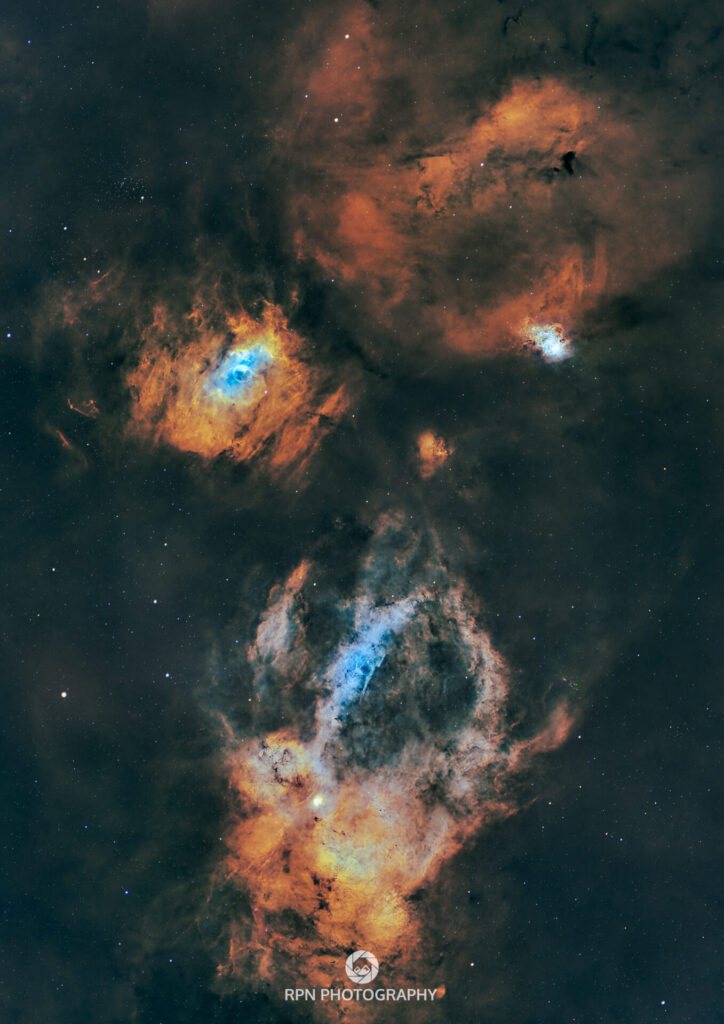The BV’s astrophotographer Rob Nolan is back – and counting the days to those long winter nights
Summer seemed to give way to autumn spectacularly quickly this year, didn’t it? It did feel like we just spent our UK summer swinging wildly from one extreme to another! But … while the earth’s weather has been severely changeable, we can always rely on the celestial calendar – it never falters and rarely surprises … except for the odd new comet, meteor or supernova!
The image this month is a bit of a revisit. Longstanding readers may recall a similar image of the Bubble Nebula (NGC 7635) back in the November 2021 issue. However, my recent image is vastly improved, using a dedicated mono camera and narrowband filters and using the SHO colour palette. The Bubble Nebula really comes to life in this wide field shot, which lies in the constellation Cassiopeia. The Bubble itself (top left) is created by the stellar wind from a massively hot, 8.7 magnitude young central star, catchily-named SAO 20575. The nebula is near a giant molecular cloud which acts as a container to the expansion of the Bubble Nebula, while itself being excited by the hot central star, causing it to glow.
Shooting wide field enables us to see all the surrounding objects in these vast nebulas, such as SH2-157 (the Lobster Claw nebula), shown towards the bottom of the image. The distinctive claw is unmistakable in shape, which is caused by stellar winds being driven by large stars giving off radiation in the region.
This month’s image was captured with my 340mm Refractor Telescope and the ZWO ASI2600MM Pro Astro camera with narrowband filters and is about 17.5 hours of data.
The night sky, October 2023 – Rob’s guide for your stargazing this month:
While September was a relatively quiet month for astronomical observations, things certainly liven up again in October – it’s a good time to start observing the Pleiades once again. We’ll also be in for a treat when Halley’s Comet produces shooting stars across our skies as bits of the comet smash into our atmosphere, and a minor lunar eclipse ends this month with a celestial crescendo!
You certainly can’t have failed to notice that the nights are drawing in, and on those (rare!) clear nights, the stars and constellations are taking on a new, brighter form. It’s as though someone peeled back the curtain liner to reveal that stunning black night sky once again.
Everyone I talk to at work or at the pub is saddened by the nights drawing in – but not us. We amateur astronomers are rolling up our sleeves and ready to go to work!
Now’s the time to grab the largest telescope you can and start observing the planets. The mighty gas giant Jupiter is dominating our night skies at the moment, and the Great Red Spot, a storm that – just by itself – is bigger than planet Earth, is visible. It looks like the storm and the Red Spot have been shrinking for at least a century, but it’s not likely to disappear any time soon.
Venus and Saturn are also visible this month, so I’d definitely recommend taking an astronomical stroll around our very own backyard.
If you’re up and about before dawn on the 10th October, Venus hangs below the Crescent Moon with Regulus, the brightest star in the Leo constellation, in between them.
The following night on the 11th, you’ve another chance to see a repeat act.
This could be a great year for Orionid meteor shower, overnight on 21st/22nd October, as Halley’s Comet makes another pass around our planet and creates a dazzling heavenly fireworks display.
Please clouds, take the night off for this one!
At the end of the month on the 28th, there will be a partial lunar eclipse visible across Europe, Africa and Asia, and Jupiter will also be sitting on the sidelines. When looking at the Moon, 12 per cent of the surface will be obscured, starting at 20:35 and ending at 21:53.
Finally, on 29th October, we’ll wave goodbye to British Summer Time, and the real astrophotography fun can begin!
A question for YOU.
In the build up to Christmas, I’m going to open up the December image to BV readers. Send in your ideas – what celestial object would you like to see featured? Something I’m capable of imaging and can see from our hemisphere of course!
Get thinking about what you’d like to see, and drop me a message via Facebook or Instagram.
I’ll also be sharing a post on the BV’s Facebook group in due course.
Until then, clear skies!


